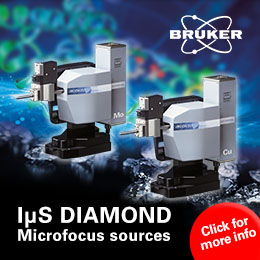


Feature article
Some musings on crystals of quartz
![Quartz crystals [Quartz crystals]](https://www.iucr.org/__data/assets/image/0017/141164/final3.gif)
Try this. Go to Google and type in “crystals” and see what comes up. On looking for crystals of quartz I found the following:
This is the true ‘energiser’ crystal. Its clarity and simplicity are the keys to its power. It raises the vibration of the user and opens up the channels for healing and communication. When cloudy, it is believed to be a doorway to the mysteries. When clear, it is the power of Mother Earth herself. With Clear Quartz Crystal on or near you – you will experience an uplift of spiritual energy that imbues you with added strength and insight. As a healing crystal it works on all the chakras: balancing, clearing and energising. Clear Quartz Crystal has long been associated with mystics and magicians. Crystals and minerals remind us of the ‘elemental’ powers. In their solidity and bulk they appear unchanging and permanent. However, the real magic in them is that it is all an illusion and really they are constantly changing and evolving.
Clear Quartz Crystal is the true alchemist. Its transformation is a slow steady pulse in tune with the beat of Mother Earth. Those sensitive enough to attune can access the libraries within them. They all have a memory, some greater than others. It is about finding the right one for you.
Also, take a look at Gwyneth Paltrow’s website https://goop.com/wellness/spirituality/the-8-essential-crystals/. Now, I am sure that you will all have seen lots of pseudoscientific garbage like this. Unfortunately, it is pervasive, and I have met several otherwise sensible, even well educated, people who nonetheless accept this nonsense. I have several times given talks about this other world of “pseudo-crystallography” to general audiences, only to find during question time that many still think there is something magical about crystals, that they emanate some sort of energy (they often use the quantum-mechanical term: energy levels!). I was even once threatened with violence by a man who phoned me to ask about the nature of crystals. The conversation started sensibly enough, but when I eventually said to him that crystals are the “deadest” objects in the universe, no energy emissions, no auras, no chakras, nothing, nada, he turned nasty and, in the end, I reported the call to the police. People do not like having their cherished beliefs overturned. I think that we crystallographers need to speak out about such beliefs.
But I digress. I thought that it might be of interest to explain a few things about quartz crystals that you may not be aware of. It is one of my hobby-horses. I am sure you have all seen quartz crystals and so I have no need to describe them to you. They do look magical, but that is merely a consequence of their obvious symmetry coupled with a clear transparency. Such crystals are also known as rock crystal. Now the crystal structure of quartz has been well documented for around 80 years and you would have thought that there can be little more to say about it. But you would be wrong! Quartz crystals are extremely complex, especially regarding their habit and varieties of twinning. A good website to learn about the complexities of quartz crystals is http://www.quartzpage.de/intro.html. Synthetic quartz crystal is a strategic material with particular applications in frequency control (more on this later) with a global annual market value of around USD 72 million in 2017, projected to grow to around USD 95 million by 2022.
The first point to note is that from a crystallographic point of view the majority of structure descriptions in the literature are in fact incorrect. The first problem arises because quartz crystallizes in one of two possible space group types, P3121 and its enantiomorph P3221 (so-called left and right crystals, respectively). Furthermore, there are two possible orientations, known as obverse and reverse, when viewed perpendicular to the c axis. This makes for four possible arrangements. To complicate things even more, we crystallographers normally refer to crystal structures using a right-handed coordinate system, whereas crystal growers, using the crystal morphology as a criterion, refer to right and left crystals using axes of opposite hand! So that now gives us eight possible descriptions. Does this matter? Well it does if you want to order a slice of quartz in a particular orientation from a supplier: be aware that you may not get the actual cut you wanted.
![[Figure 1]](https://www.iucr.org/__data/assets/image/0003/141078/Figure1.png) Figure 1. The quartz crystal purchased by the author.
Figure 1. The quartz crystal purchased by the author.As far back as 1978, Donnay and Le Page[i] wrote the definitive paper on this problem, entitled “On the vicissitudes of the settings of quartz”, which gave a complete set of explanations and recommendations. However, despite this, errors continued to occur. Because of this I recently felt obliged to add my own contribution to the discussion by writing up a simple description in a recent paper[ii] that I dedicated to the late Helen Megaw, who had tried hard herself to get the structural description right, but in the end she too had failed.
To understand this, a few years ago, 1811 to be precise, Dominique François Jean Arago (1786-1853), in France, observed that colour developed in plates of rock crystal when polarized light was transmitted through them in a particular direction. This was the first observation of the phenomenon that we now call optical rotation. Pretty soon this effect was observed in solutions of various organic molecules and Jean-Baptiste Biot (1774-1862), again in France, realized that this must be a property inherent in the molecules themselves: Cette proprieté consiste dans la faculté qu’ont les molécules dont il s’agit de faire tourner d’un certain angle, et dans un certain sens les axes de polarization de rayons lumineux. Such was the intense scientific interest in this phenomenon that by 1820 most of the fundamental experiments needed to understand optical rotation had already been realized. Now, earlier, René-Just Haüy (1743-1822), yet again in France, observed that certain quartz crystals, to which he assigned the name “Plagièdre”, showed unsymmetrical faces, although he thought it was a random phenomenon. Biot also discovered that, on the basis of the unsymmetrical faces, crystals of quartz could be separated into two sorts that were of opposite hand and that they rotated polarized light in opposite directions. The figure at the top of the page shows idealized drawings of left and right crystals of quartz. In 1820, the physicist Frederick William Herschel (1738-1822) working in England – yes, the famous astronomer who discovered the planet Uranus – sorted some quartz crystals in his possession depending on the direction in which the unsymmetrical faces leaned. He then arranged for each crystal to be sliced and polished and, like Biot, observed that polarized light rotated in opposite directions for the two forms. He was then able to link the sense of rotation of polarized light to the actual crystal faces, writing thus “Quartz samples whose hemihedral facets point in the same direction rotate the polarized light in that direction: a right hemihedral produces right rotation – and vice versa”.
Some years later,
in 1848, Louis Pasteur (1822-1895), in France once again, reported on his
famous experiment showing that sodium ammonium tartrate crystals could be
divided into portions that were mirror images of each other on the basis of
their morphology, and more importantly this conferred a corresponding change in
the sense of rotation of polarized light when the crystals were dissolved in
water[iii].
Personally, I consider this to be his greatest scientific discovery, because later
around 1860 Pasteur was led to the view that, as solutions of biological
organic compounds also showed optical rotation, chirality or handedness (he
called it dissymétrie) was an essential component of nature
![[Figure 2]](https://www.iucr.org/__data/assets/image/0004/141079/Figure-2.jpg) Figure 2. Right (dextro) handed quartz.
Figure 2. Right (dextro) handed quartz.Returning to timekeeping, the resonance frequency is used to control the watch’s time. In watches a frequency of 32.768 kHz is normal. However, quartz is not a particularly strong piezoelectric: there are many other materials that are more piezoelectric. However, it does have a special, and almost unique, property that is important for accurate timekeeping. To understand this, consider the formula for frequency in terms of the elastic stiffness coefficient c, the density ρ and the crystal thickness l,
![[Equation 1.1]](https://www.iucr.org/__data/assets/image/0015/141081/musings4.gif)
and then the temperature coefficient of frequency has the form
![]()
Now, the second term is the linear thermal expansion coefficient α with a value of around 10-5K-1, and the third term is proportional to α (for an isotropic solid it is 3α). Both are generally positive quantities as bonds become weaker with increasing length during rising temperature. But it is possible, in principle, that the first term, the temperature coefficient of stiffness, could cancel with the other two terms. The following table shows some examples of the temperature coefficients of the elastic stiffness for some oxides.
Table 1. Temperature coefficients of elastic stiffness in units of 10-4K-1
|
MgO |
Tc11 = -2.3 |
Tc44 = -1.0 |
|
SrTiO3 |
Tc11 = -2.6 |
Tc44 = -1.1 |
|
Quartz |
Tc11 = -0.5 |
Tc33 = -2.1 |
|
|
Tc44 = -1.6 |
Tc66 = +1.6 |
From this you can see that most coefficients are negative reflecting the fact that the crystals become softer with heating. But note that in quartz, one of the shear elastic stiffness coefficients Tc66 is actually positive. This then makes it possible for Equation (1.2) to equal zero and so, provided that the correct section of quartz is cut, the frequency can be temperature-compensated. After all, you don’t want your watch time to change when you move from a hot to a cold place! This is the main reason why quartz, rather than other piezoelectrics, is used in watches and in high-end frequency-control systems[v].
Now what is the origin of this anomalous increase in shear stiffness in quartz? The clue is in considering the change in crystal structure with temperature. At room temperature the space group is P3221 for right-dextro quartz (or P3121 for left-laevo quartz) and has distorted sixfold rings of Si-O units about the 32-fold axis at the unit cell origin. These rings are floppy. At about 846 K, there is a phase transition to a structure in space group P6222 (or P6422): in this case the 32 axis at the unit-cell origin becomes 62, and so the Si-O groups occur in perfect 62-fold rings and are then locked in place (Figure 3).
![[Figure 3]](https://www.iucr.org/__data/assets/image/0014/141080/Figure-3.gif) Figure 3. Transformation from low- to high-temperature quartz structure. Image created with CrystalMaker X.
Figure 3. Transformation from low- to high-temperature quartz structure. Image created with CrystalMaker X.So on heating from room temperature the structure tends to become stiffer against shear about the Z axis with respect to the Si-O rings. However, to achieve this temperature compensation it is necessary to select a particular cut of the crystal, and this has to be done to within a tiny fraction of a degree. The usual section is known as the AT cut and is at θ = 35°25’ (Figure 2). The website http://www.roditi.com/SingleCrystal/Quartz/QuartzHead.htm is well worth reading as it gives details on how crystals of quartz are grown and cut for frequency applications. Crystals are sliced into bars and then oriented using X-ray diffraction before being cut into the required slices. Because of the difficulty of getting the perfect cut angle, the slices are then tested for their different qualities and temperature stability and then binned according to the results, with the most expensive being those that are closest to ideal behaviour.
Having said all this, you might think that your cheap Mickey Mouse watch would be less precise than your expensive Omega. But you would be wrong. The evidence is that both can keep time to within roughly the same precision, partly because the typical temperature variations in practice are relatively small. However, in the frequency control market for electronics, military and communications industries very precise temperature compensation does matter a lot.
Let me finish with an anecdote from W. L. Bragg. I am grateful to John Helliwell for reminding me of this story:
"We were staying in Ballater, a small town on Deeside in Scotland. In the town was a tiny shop which sold tourist attractions and picture postcards, and in its minute window was a very fine specimen of smoky quartz mineral. Buying a postcard, I said to the proprietor, ‘That’s a fine group of smoky quartz in your window’ and had this reply in very broad Scotch: ‘That’s no smoky quartz, that’s topaz. It’s a crystal. You can tell crystals by the angles between their faces. If you’re interested I’ll lend you a book on the subject.’ I knew enough (crystals being rather in my line) to be sure it was smoky quartz and on return to base looked up a book on Mineralogy which said ‘Smoky Quartz, also known as Cairngorm, is called Topaz in Scotland."
[i] Donnay, J. D. H. & Le Page, Y. (1978). On the vicissitudes of the settings of quartz. Acta Cryst. A34, 584–594.
[ii] Glazer, A. M. (2018). Confusion over the description of the quartz structure yet again. J. Appl. Cryst. 51, 915-918.
[iii] An excellent detailed review of Pasteur’s work on crystals is given by Flack, H.D. (2009). Louis Pasteur’s discovery of molecular chirality and spontaneous resolution in 1848, together with a complete review of his crystallographic and chemical work. Acta Cryst. A65, 371-389.
[iv] By the way, we know that the sense of rotation correlates with the helical arrangement of Si-O groups around the 31 (or 32) axes of symmetry at 1/3, 2/3, z for laevo (or dextro) quartz. This has caused confusion in the past because when we talk about rotation of polarized light we consider the light coming towards the viewer, but when we refer to a helical arrangement in the crystal structure the convention is to define the sense of the helices away from the viewer. Thus, in right (dextro) crystals of quartz the corresponding helices around the 32 axes are left-handed!
[v] You can read more about this in a 1973 article by R. E. Newnham at http://www.dtic.mil/dtic/tr/fulltext/u2/760766.pdf.
Copyright © - All Rights Reserved - International Union of Crystallography





